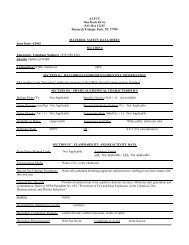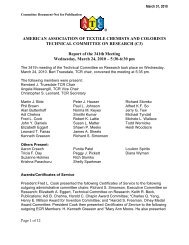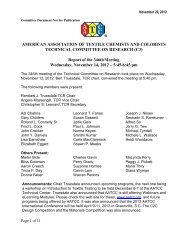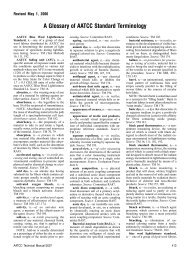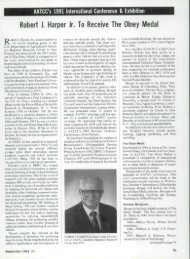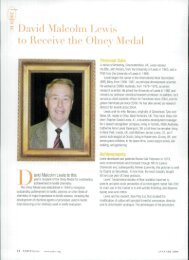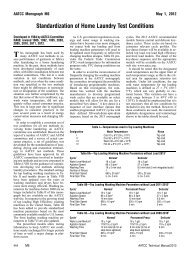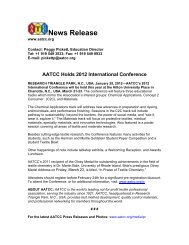November 2009 - AATCC. American Association of Textile Chemists ...
November 2009 - AATCC. American Association of Textile Chemists ...
November 2009 - AATCC. American Association of Textile Chemists ...
Create successful ePaper yourself
Turn your PDF publications into a flip-book with our unique Google optimized e-Paper software.
Committee Document-Not for Publication<br />
Page 1 <strong>of</strong> 11<br />
�<br />
<strong>November</strong> 30, <strong>2009</strong><br />
AMERICAN ASSOCIATION OF TEXTILE CHEMISTS AND COLORISTS<br />
TECHNICAL COMMITTEE ON RESEARCH (C3)<br />
Report <strong>of</strong> the 340th Meeting<br />
Wednesday, <strong>November</strong> 11, <strong>2009</strong> – 5:45-6:45 pm<br />
The 340th meeting <strong>of</strong> the Technical Committee on Research took place on Wednesday,<br />
<strong>November</strong> 11, <strong>2009</strong>. Elizabeth Eggert, TCR chair, convened the meeting at 5:35 pm.<br />
The following members were present:<br />
Elizabeth A. Eggert TCR Chair<br />
Rembert J. Truesdale III, TCR Vice Chair<br />
Christopher S. Leonard, TCR Secretary<br />
Martin J. Bide<br />
Fred L. Cook<br />
John Y. Daniels<br />
Thomas Fabian<br />
Leonard T. Farias<br />
Kenneth Greeson<br />
Peter J. Hauser<br />
Paul L. Johnson<br />
Others Present:<br />
Aaron Creech<br />
Tricia F. Day<br />
Mason Epperly<br />
Judy Holden<br />
Norma M. Keyes<br />
Calvin Lam<br />
Robert K. Lattie<br />
Richard A. Malachowski<br />
Susan L. Matter<br />
Shawn P. Meeks<br />
Luther M. Myers<br />
Nancy PeBenito<br />
David L. Ramey<br />
Suzanne Holmes<br />
Smrithi Kumar<br />
Angela Massengill<br />
Carrie McDermitt<br />
James A. Sheets<br />
Richard S. Simonson<br />
Richard Slomko<br />
Alfred K.F. So<br />
Jerry G. Tew<br />
Adam R. Varley<br />
Michele L. Wallace<br />
Heidi Woodacre<br />
Punita Patel<br />
Peggy J. Pickett<br />
Elizabeth Turnbull<br />
Diana Wyman<br />
Announcements:<br />
Chair Eggert announced upcoming symposia, one being the Fashion Trends,<br />
Technologies, and Sustainability in Denim and Garment Wet Processing to be held<br />
December 9-10, <strong>2009</strong> in Long Beach, California. Also she announced <strong>AATCC</strong> Global<br />
Conference & Exhibition “Emerging Trends in <strong>Textile</strong> Processing for a Sustainable<br />
Future,” to be held January 28-30, 2010 at the Bombay <strong>Textile</strong> Research <strong>Association</strong> in<br />
Mumbai, India.<br />
Eggert also announced the change in the spring committee meetings for 2010<br />
only. The dates will be March 23-25, 2010 at the Radisson Hotel, Research Triangle
Park, N. C. The committee meetings are being held in March to allow <strong>AATCC</strong> to hold<br />
their annual International Conference in conjunction with the MegaTex show in Atlanta,<br />
Georgia. The <strong>AATCC</strong> International Conference will be held May 18-20, 2010 at the<br />
Georgia World Congress Center in Atlanta, Georgia.<br />
Eggert also announced that the 2010 TCR Service Award recipient has been<br />
chosen and will be announced at the <strong>AATCC</strong> International Conference in May 2010.<br />
RA23, Colorfastness to Water: A committee ballot will be submitted for TM 104<br />
(Colorfastness to Water Spotting) with revisions on specimens to specimen; adding<br />
tolerance to specimen size, and add to scope that “whites can also exhibit color change,<br />
such as yellowing.” The interlaboratory trial for TM 162 (Colorfastness to Water:<br />
Chlorinated Pool) has been completed. Chris Leonard <strong>of</strong> <strong>AATCC</strong> will summarize data to<br />
send to the committee for review to determine if the data can be used for a precision and<br />
bias statement and/or add an option using smaller canisters. The interlaboratory trial for<br />
TM 107 (Colorfastness to Water) has been conducted to determine if the testing time<br />
can be reduced from 18 hours. Data shows that staining changes over time. A poll <strong>of</strong> the<br />
labs participating will be done. Leonard will summarize data and send out to the<br />
committee. A change in the protocol for the next round will use distilled water or<br />
deionized water and instead <strong>of</strong> boiled water distilled or deionized. A poll will also be<br />
taken regarding what type oven the labs are using in the pr<strong>of</strong>iciency testing for<br />
perspiration. A question came up on should TMs 15, 106, 107 and 162 apply to white<br />
fabrics? The committee proposed an addition to the scope for new or reaffirmed<br />
methods that whites can also exhibit color change such as yellowing.<br />
RA24, Fiber Analysis: A recent TCR ballot for proposed revision <strong>of</strong> TM 20-2007, Fiber<br />
Identification: Qualitative, to reflect an addition in the development statement stating that<br />
it is “Related to ISO Document 2076,” and that Lyocell is being deleted from the Man-<br />
Made List <strong>of</strong> Fibers as it is already listed under Rayon as well as a reference to China’s<br />
Document GB 16-2262, was approved and will appear in the 2011 <strong>AATCC</strong> Technical<br />
Manual. A recent TCR letter ballot for proposed revision <strong>of</strong> TM 20A-2008, Fiber Analysis:<br />
Quantitative, to reflect a ruggedness test provided by the Spandex Subcommittee to<br />
develop a solvent separation procedure 8 using Dimethylacetamide and other editorial<br />
and minor technical changes, were approved and will be published in the 2011 <strong>AATCC</strong><br />
Technical Manual. All negatives were resolved for these two items. Results <strong>of</strong> the most<br />
recent 71 lab international pr<strong>of</strong>iciency testing were reviewed. A significantly reduced<br />
amount <strong>of</strong> both interlab and intralab variation was observed in the no finish mohair/wool<br />
blend as compared to the heavy finish add on blend analyzed in the previous pr<strong>of</strong>iciency<br />
testing. The spandex/cotton blend pr<strong>of</strong>iciency testing showed good agreement both<br />
between and within labs. Blends for the upcoming pr<strong>of</strong>iciency testing were determined to<br />
be acrylic/wool and camel/wool. An extraction note concerning the mohair/wool heavy<br />
finish sample will be distributed to committee members. A statistical analysis by Robert<br />
Cleaver <strong>of</strong> the RA102, Statistics Committee, indicated that data from the <strong>AATCC</strong><br />
pr<strong>of</strong>iciency trials can be used to provide a Precision and Bias Statement for a particular<br />
blend type, using data from the 80 lab international Acetate/Rayon pr<strong>of</strong>iciency testing as<br />
an example. Two new subcommittees were created: the Differential Scanning<br />
Calorimetry (DSC) Subcommittee comprised <strong>of</strong> FITI, Clemson University and Vartest;<br />
Page 2 <strong>of</strong> 11
and the Cationic Dyeable Polyester Subcommittee comprised <strong>of</strong> FITI, Fred David and<br />
Vartest. Data from DuPont concerning triexta fiber was reviewed and suggestions for<br />
inclusion <strong>of</strong> triexta into TMs 20 and 20A will be sent to committee ballot. DSC data<br />
provided by DuPont will not be included until the DSC Subcommittee has completed<br />
work on developing a standard DSC protocol for inclusion in either method or both.<br />
Communication will be made with Dow/Cargil/Natureworks so that information<br />
concerning PLA can also be included in TMs 20 and 20A. The proposed new Color<br />
Supplement to TMs 20 and 20A was reviewed with the current contents including: first<br />
order red plate images <strong>of</strong> generic fiber types; examples <strong>of</strong> <strong>AATCC</strong> multifiber strips<br />
stained with fiber identification stain; examples <strong>of</strong> energy dispersive x-ray maps <strong>of</strong><br />
metallic fibers with inductively coupled plasma analysis also supplied; listing <strong>of</strong> *.SP<br />
Fourier transform infra red files available from <strong>AATCC</strong>; and table <strong>of</strong> pr<strong>of</strong>iciency testing<br />
coefficient <strong>of</strong> variations for various fiber blends.<br />
RA31, Antimicrobial Activity: A proposed revision <strong>of</strong> TM 174 (Antimicrobial Activity<br />
Assessment <strong>of</strong> Carpets) has had two outstanding negatives on the issue <strong>of</strong> shaving<br />
carpet fibers. Two solutions were provided to address the negatives: (1) remove the<br />
<strong>AATCC</strong> TM 174 from the manual; or (2) reference the sample preparation only from an<br />
ASTM E 2471 test method which allows for shaving <strong>of</strong> carpet fibers prior to testing. It<br />
was decided that the first solution was not an option and the second solution was an<br />
acceptable option. The committee needs a vote on this in the next 45 days. Three<br />
committee members have agreed to review this method and add the reference to ASTM<br />
E 2471, plus clean-up some editorial issues. Once this is completed it will be sent to<br />
committee ballot. TMs 30 (Antifungal Activity, Assessment on <strong>Textile</strong> Materials: Mildew<br />
and Rot Resistance <strong>of</strong> <strong>Textile</strong> Materials), 147(Antibacterial Activity Assessment <strong>of</strong> <strong>Textile</strong><br />
Materials: Parallel Streak Method) and reactivation <strong>of</strong> TM 90 (Antibacterial Activity <strong>of</strong><br />
Fabrics, Detection <strong>of</strong>: Agar Plate Method) have current and pending ballots which are in<br />
the process <strong>of</strong> being updated. Round robin test samples on a proposed Hydrophobic<br />
Fabric Method were sent to David Ramey <strong>of</strong> Microban and chair <strong>of</strong> RA31. The samples<br />
have had issues <strong>of</strong> being too hydrophobic; however, when washed the antimicrobial<br />
properties are also washed out or lost. Some preliminary testing will be done on the<br />
samples prior to sending them out for the round robin. Bill Hanrahan was nominated for<br />
committee chair beginning January 2010. Beth Joiner <strong>of</strong> NASMA is acting secretary.<br />
Pr<strong>of</strong>iciency test programs for <strong>AATCC</strong> Methods 100 (Antibacterial Finishes on <strong>Textile</strong><br />
Materials: Assessment <strong>of</strong>) and 147 were discussed and anyone interested in<br />
participating was asked to let David Ramey know. <strong>AATCC</strong> plans to launch this program<br />
in October 2010. Guidelines for testing will be provided to each participating lab with test<br />
samples with six weeks to complete the work. Samples will be sterilized prior to<br />
distribution and will most likely be cotton/poly blend supplied by Cotton Incorporated.<br />
RA33, Colorfastness to Atmospheric Contaminants: Lot 20 control fabrics have been<br />
approved for TM 23, Colorfastness to Burnt Gas Fumes, and it is now available from<br />
Testfabrics. Data (from seven labs) will be used for a precision and bias statement and<br />
will be sent for committee ballot for reaffirmation with the P&B statement. Two negatives<br />
for a proposed committee ballot for TM 109 (Colorfastness to Ozone in the Atmosphere<br />
under Low Humidities) were resolved. The method will be re-balloted to committee<br />
Page 3 <strong>of</strong> 11
expanding the ozone concentration and time. <strong>AATCC</strong> needs to review the instrumental<br />
endpoint <strong>of</strong> the control fabric for TM 129 (Colorfastness to Ozone in the Atmosphere<br />
under High Humidities). <strong>AATCC</strong> is waiting for results from one <strong>of</strong> the three labs. There<br />
may be a need to edit the end point in the method to reflect reality. Data from the round<br />
robin for TM 164 (Colorfastness to Oxides <strong>of</strong> Nitrogen in the Atmosphere under High<br />
Humidities), will generate a precision and bias statement which will undergo a committee<br />
ballot.<br />
RA34, Preparation: The committee is working on a proposed revision <strong>of</strong> Method 89<br />
(Mercerization in Cotton). TM 89 needs to be revised to include an auto-titration and an<br />
option for instrumental analysis. There is a concern that fabrics treated with liquid<br />
ammonia may interfere with such instrumental analysis. A study will be conducted prior<br />
to this revision being balloted. The committee would like to post a note in <strong>AATCC</strong> Review<br />
and the <strong>AATCC</strong> Newsletter asking for labs and interest in updating this method.<br />
Comparison <strong>of</strong> ISO 3071 (pH by Shaker method) to <strong>AATCC</strong> Method 81 (pH by boildown)<br />
was done by FITI in Korea. It was stated that there is a need to show that the two<br />
methods are not the same and that a statement should be added to TM 81 stating this<br />
method is not applicable to finished textiles. Ken Greeson will work with Len Farias, chair<br />
<strong>of</strong> RA34, on this revision. There will be an interlab study conducted in 2010 with a rewrite<br />
<strong>of</strong> Method 81. The presentation from David Hinks <strong>of</strong> North Carolina State University<br />
presented “Green Chemistry for Bleaching <strong>of</strong> Cotton,” which is a unique approach to the<br />
use <strong>of</strong> activators for hydrogen peroxide bleaching, was well received.<br />
RA36, Color Measurement: EP9 (Visual Assessment <strong>of</strong> Color Difference <strong>of</strong> <strong>Textile</strong>s)<br />
was re-submitted to committee ballot and a TCR ballot and was approved. Changes will<br />
appear in the 2011 <strong>AATCC</strong> Technical Manual. Proposed revisions <strong>of</strong> EP8 (<strong>AATCC</strong> 9-<br />
Step Chromatic Transference Scale) to set color coordinates and tolerances for the 9-<br />
Step Chromatic Transference Scale was balloted to committee and TCR and was<br />
approved. Changes will be reflected in the 2011 <strong>AATCC</strong> Technical Manual. A proposed<br />
new evaluation procedure on the “Instrumental Calculation <strong>of</strong> the Gray Scale for<br />
Staining” underwent a re-write and was submitted for both committee and TCR letter<br />
ballots and was approved. The new evaluation procedure will be published in the 2011<br />
<strong>AATCC</strong> Technical Manual. A discussion <strong>of</strong> EP11 (Spectrophotometer UV Energy<br />
Calibration Procedure for Optically Brightened <strong>Textile</strong>s) and TM 110 (Whiteness <strong>of</strong><br />
<strong>Textile</strong>s) on the use <strong>of</strong> SCI and SCE rendered a decision to collect more information. It<br />
was also decided to add a photograph to the procedure to show proper placement. The<br />
EP11 has a study underway to validate target CIE whiteness value. It was decided to<br />
wait on the proposed revision <strong>of</strong> EP11 and do both at the same time. TM 182 (Relative<br />
Color Strength <strong>of</strong> Dyes in Solution) is up for reaffirmation. Comments will be requested<br />
from committee members. Data for the proposed lighting study for 3500K light sources is<br />
still <strong>of</strong> interest to the committee. David Hinks will investigate creation <strong>of</strong> a master’s<br />
student project.<br />
RA38, Colorfastness to Crocking: The committee discussed the white crock square<br />
test cloth, as a result <strong>of</strong> another discussion about thread count tolerance. Testfabrics<br />
suggested broadening the tolerance <strong>of</strong> fabric weight. The committee feels that weight<br />
Page 4 <strong>of</strong> 11
cannot be changed without doing a study which would include <strong>AATCC</strong> and ISO crock<br />
cloth. The “blind” crock study will be done by Natick Labs. SDL Atlas and James Heal<br />
Co. will provide fabric for the study. Susan Gassett <strong>of</strong> Natick, chair, will bring results to<br />
the next committee meeting. Visual and spectro readings/measurements will be done.<br />
Widening the whiteness tolerance <strong>of</strong> the crockmeter cloth will be looked at as part <strong>of</strong> the<br />
study. A verification cloth for TM 116 (Colorfastness to Crocking: Rotary Vertical<br />
Crockmeter Method) is being looked into. A question was raised to the committee about<br />
crocking whites with colored test cloth. The committee decided that this is a different test<br />
method and that ASTM may have a method that addresses a similar procedure. Susan<br />
Gassett was re-nominated to be chair beginning 2010.<br />
RA42, Dimensional Change: TM 179 (Skewness Change in Fabric and Garment Twist<br />
Resulting from Automatic Home Laundering) has been separated into two proposed<br />
methods, which will require precision and bias statements. The proposed drafts will be<br />
sent to the committee for review only along with data set for a proposed P&B. The chair<br />
will contact Jodie Lynch and request a draft <strong>of</strong> the proposed new sock and hosiery test<br />
method for dimensional change to be sent out to the committee for review only.<br />
RA43, Pr<strong>of</strong>essional <strong>Textile</strong> Care: TMs 86 (Drycleaning: Durability <strong>of</strong> Applied Designs<br />
and Finishes) and 158 (Dimensional Changes on Drycleaning in Perchloroethylene<br />
Machine Method) are due for reaffirmation and will be coordinated through RA43. Mack<br />
Davis <strong>of</strong> Medlin Davis Inc. presented a talk on “Green Earth Cleaning,” which was well<br />
received.<br />
RA50, Colorfastness to Light: The committee is continuing to split the proposed<br />
revision <strong>of</strong> TM 16 (Colorfastness to Light) into three parts, Carbon, Xenon and Outdoor,<br />
per the request <strong>of</strong> Committee RA99, Technical Manual Editorial Review. Regarding the<br />
Blue Wool Update, nylon flag material looks promising. The committee also agreed to<br />
investigate a wool material. The ISO 105-B10 ruggedness test approves use <strong>of</strong> flat bed<br />
testers. The new chair will be Lisa Strachan beginning 2010 and Rich Slomko will be<br />
secretary. It was announced that <strong>AATCC</strong> has relinquished secretariats <strong>of</strong> TC38-SC1 and<br />
SC2. Also announced was that ISO 105-B08 has been revised.<br />
RA56, Stain Resistance: The acting chair <strong>of</strong> RA56, Paul Johnson with 3M Co., has tried<br />
to resolve several negatives on a recent TCR ballot for proposed revision <strong>of</strong> TM 130 (Soil<br />
Release: Oily Stain Release Method). One negative has now been resolved; however,<br />
Johnson is still pursuing the other negative. There was a request for additional stains to<br />
be addressed by a reference to ASTM Method D 4265. The committee will develop core<br />
variables for assessing protocol for test method for High Efficiency front loading<br />
machines. There is a potential for developing a pr<strong>of</strong>iciency program for TM 130. A pilot<br />
program will be put on hold until the TM 130 revision is completed and published. Paul<br />
Johnson was re-nominated as chair <strong>of</strong> RA56 beginning January 2010 with Mark Granja<br />
<strong>of</strong> Sun Products as secretary.<br />
RA57, Floor Covering: <strong>AATCC</strong> TMS 121 (Carpet Soiling: Visual Rating Method), 138<br />
(Cleaning: Washing <strong>of</strong> <strong>Textile</strong> Floor Coverings) and 171 (Carpets: Cleaning <strong>of</strong>: Hot<br />
Page 5 <strong>of</strong> 11
Water Extraction Method) are due for reaffirmation. These were discussed and approved<br />
to move forward to TCR ballot for reaffirmation. Richard Turner will organize an<br />
interlaboratory trial for a new bleach resistance test method. Alan Buttenh<strong>of</strong>f will<br />
organize an interlab trial for the new moisture permeability method. Turner will also<br />
organize an interlab trial for static charge analysis <strong>of</strong> carpets. Bijan Seyfzadeh reviewed<br />
his work on an alternative method <strong>of</strong> making the Red Dye 40 Scales. The product he<br />
exhibited looked quite promising and would be much less labor and cost demanding.<br />
Volunteers for new chair were requested but no one volunteered. Alan Buttenh<strong>of</strong>f will<br />
continue as acting chair until a new chair can be found.<br />
RA59, Fibrous Test Materials: There was a discussion about the effects <strong>of</strong> the ECR<br />
equipment listing policy concerning test methods that include references to multifiber<br />
fabrics. There was a motion to send a request to the chairs <strong>of</strong> the committees that have<br />
methods with multifiber fabric to include the following statement, “in accordance with<br />
Evaluation Procedure 10, Multifiber Adjacent Fabrics: Evaluation <strong>of</strong>.” A request will also<br />
be sent to all committees with ballast fabrics to propose technical and editorial changes<br />
regarding table descriptions <strong>of</strong> those fabrics. A request will be sent to Committees RA38<br />
and RA57 that they propose possible synchronization <strong>of</strong> crockmeter fabric specifications<br />
in their methods and ISO related test methods. The committee is still waiting for Carol<br />
Graham’s review <strong>of</strong> <strong>AATCC</strong> EP 10 for consideration in ISO 105-F10. RA59 is also<br />
waiting for staining results <strong>of</strong> proposed single fiber adjacent acetate fabric.<br />
RA60, Colorfastness to Washing: TMs 61 (Colorfastness to Laundering: Accelerated),<br />
172 (Colorfastness to Powdered Non-Chlorine Bleach in Home Laundering), 188<br />
(Colorfastness to Sodium Hypochlorite Bleach in Home Laundering) and 190<br />
(Colorfastness to Home Laundering with Activated Oxygen Bleach Detergent:<br />
Accelerated) were balloted to committee and TCR for inclusion <strong>of</strong> liquid detergent and all<br />
were approved. These changes will appear in the 2011 <strong>AATCC</strong> Technical Manual.<br />
Numerous comments and modifications were received regarding the format <strong>of</strong> TM 61. A<br />
task group has been formed to review and make these changes. The group will meet<br />
soon in order to get a committee ballot out in December. Norma Keyes has agreed to act<br />
as chair for RA60 until a permanent replacement can be found.<br />
RA61, Appearance Retention: A training video for TM 124 (Smoothness Appearance <strong>of</strong><br />
Fabrics after Repeated Home Laundering) was provided by Cotton Incorporated and<br />
reviewed by Peggy Pickett and Chris Leonard <strong>of</strong> <strong>AATCC</strong>. It was discussed that the video<br />
needs to be formatted to be included as an eLearning module. The current video focuses<br />
on key points but does not cover all details needed for an actual training video. It was<br />
also discussed that all the test methods related to RA61 should be included. Ken<br />
Greeson, chair, will work with Pickett on this item. The committee is waiting for input from<br />
David Hinks <strong>of</strong> NCSU regarding the light intensity project. Greeson will look into this and<br />
also check the material list in the Figure 1 description for lighting. It was discussed that<br />
all the RA61 methods should be included in this project. The proposed ballast change in<br />
TMs 88B (Smoothness <strong>of</strong> Seams in Fabrics after Repeated Home Laundering), 88C<br />
(Retention <strong>of</strong> Creases in Fabrics after Repeated Home Laundering), 124 and 128<br />
(Wrinkle Recovery <strong>of</strong> Fabrics: Appearance Method), for Type 3 in Table I-Wash Load<br />
Page 6 <strong>of</strong> 11
Ballast: Finished Fabric Specification, should be changed to Fabric Specification and<br />
further classified as Greige and Finished specs. Yarn tolerance change was also<br />
discussed for Type 1 and Type 3; the yarn for Type 3 will be 16/1 ring spun instead <strong>of</strong><br />
30/2 ring spun in the future. Greeson will discuss with Leonard regarding changes<br />
required for Table I. The angles <strong>of</strong> grading board for these methods were discussed as<br />
well. An update from John Crocker and Norma Keyes for the angle calculation was given<br />
but it was discussed and approved to remove angle information and keep only<br />
dimensions from Figure 1. Greeson will work with Leonard on this proposed change. The<br />
discussion <strong>of</strong> a new test using the Dynawash for accelerated testing for durability on<br />
prints and applied designs such as glitter and rhinestones was tabled until the March<br />
2010 meeting. New business entailed RA61’s methods’ tables for laundering conditions<br />
either need to be constantly changed or remove them and put a note to refer to the<br />
current standards <strong>of</strong> home laundering test conditions monograph. Also, Cotton<br />
Incorporated has an Automated Crease Recovery Angle tester that can be used for TM<br />
66 (Wrinkle Recovery <strong>of</strong> Woven Fabrics: Recovery Angle). A preliminary study was<br />
conducted in which the automated tester was compared to TM 66 data on the same<br />
fabric (tested at the University <strong>of</strong> Georgia), and the results were encouraging. A survey<br />
will be conducted for the committee to determine the level or interest for adding an<br />
automated option to TM 66. RA61 will have a speaker to be confirmed for the March<br />
2010 meeting.<br />
RA63, Water Resistance, Absorbency and Wetting Agent Evaluation: <strong>AATCC</strong> TMs<br />
17 (Wetting Agents, Evaluation <strong>of</strong>), 22 (Water Repellency: Spray Test), and 70 (Water<br />
Repellency: Tumble Jar Dynamic Absorption Test) are due for reaffirmation in 2010.<br />
These methods were discussed and approved to go forward for a TCR ballot for<br />
reaffirmation. Precision and Bias data has been collected for the current TM 79<br />
(Absorbency <strong>of</strong> <strong>Textile</strong>s) and the proposed Option B protocol. Data presented to the<br />
group demonstrated statistical significance. Once the P&B data analysis is complete, the<br />
proposed revision will be sent to committee ballot. Regarding the proposed new methods<br />
on Wicking <strong>of</strong> <strong>Textile</strong>s, Precision and Bias data has been collected for the vertical and<br />
horizontal sample orientation protocols. Analysis <strong>of</strong> the data collected for the horizontal<br />
orientation protocol has been completed and is ready to move forward to a committee<br />
ballot when the P&B statement is completed. Analysis <strong>of</strong> the data collected for the<br />
vertical orientation, however, revealed that further analysis is needed to correctly<br />
interpret initial and final condition measurements. In order to not delay the balloting <strong>of</strong> the<br />
horizontal orientation, the committee decided to separate the two proposals into two<br />
proposed methods. Three test method proposals on Drying Time were discussed by the<br />
group: (1) a new method proposed by Cocona Incorporated based on the ATS<br />
(gravimetric mass loss); (2) the previously proposed gravimetric mass loss rate method;<br />
and (a new method proposed by Cocona Inc. based on temperature differences induced<br />
by evaporative cooling rate. The three proposed methods will be distributed to the<br />
committee for commenting along with notice <strong>of</strong> formation <strong>of</strong> a subcommittee to review<br />
various drying time methods. The subcommittee will review all comments at a web<br />
conference in December. The subcommittee will also meet during the spring meetings in<br />
March 2010 prior to the full RA63 committee meeting. Michele Wallace was nominated<br />
as the new chair beginning January 2010.<br />
Page 7 <strong>of</strong> 11
RR68, Odor Determination Test Methods (Exploratory Reactivation Meeting): An<br />
exploratory reactivation meeting <strong>of</strong> Reference Committee RA68, Odor Determination<br />
Test Methods, with Adam Varley <strong>of</strong> Vartest acting as chair, was held to discuss possible<br />
reactivation, revising/updating Test Method 112 (Formaldehyde Release from Fabric,<br />
Determination <strong>of</strong>: Sealed Jar Method), and discussing other CPSIA issues that may<br />
affect the members <strong>of</strong> the <strong>Association</strong>. It was unanimously decided to reactivate RR68<br />
as well as RR45 (Finish Analysis Test Methods) and to have both meet jointly in March<br />
2010 in order to accommodate the need for both low level formaldehyde detection as<br />
well as odor issues which may or may not be formaldehyde related. Michele Wallace <strong>of</strong><br />
Cotton Incorporated was designated as the person responsible for determination <strong>of</strong><br />
possible committee chairs. The possibility <strong>of</strong> ultimately merging the two reactivated<br />
committees was also raised. The attendance list for the meeting was given to Tricia Day<br />
<strong>of</strong> <strong>AATCC</strong> so that a formal list <strong>of</strong> RR45 and RR68 members can be assembled. An email<br />
with a committee application blank will be submitted to those in attendance for<br />
interested persons to join the committee. RR68 noticed several areas in TM 112 that<br />
requires upgrades to improve the method and decided to review possible text upgrade<br />
alternatives at the March 2010 meeting. The advantages <strong>of</strong> adding a water extract<br />
alternative to air incubation was brought up as a point to be continued during discussion<br />
as was the advantage <strong>of</strong> reducing aliquot size. RR68 determined that running a<br />
ruggedness, precision and bias and/or pr<strong>of</strong>iciency trial focusing on lower levels <strong>of</strong><br />
formaldehyde around 150 ppm or less would be very useful and will be on the agenda for<br />
the March meeting. RR68 determined development <strong>of</strong> a new Formaldehyde in <strong>Textile</strong>s<br />
Monograph or a note on proper use <strong>of</strong> Method 112 added to the method would be very<br />
useful. Alternatives for this text will be reviewed at the March meeting. It was noted the<br />
increasingly common presence <strong>of</strong> analytical instruments such as GCMS and HPLC in<br />
textile testing laboratories worldwide means that both RR45 and RR68 have a new and<br />
more sophisticated technical environment and membership to work with and that more<br />
sophisticated and effective test methods and related documents will, therefore, be<br />
anticipated by the committee’s activities. (Secretary’s Note: The action to reactivate<br />
RR68 and RR45 was approved by ECR at their meeting <strong>of</strong> <strong>November</strong> 12, <strong>2009</strong>.)<br />
RA75, Correlation <strong>of</strong> Laboratory Tests with End Use Performance: The committee<br />
letter ballot for proposed new name and scope <strong>of</strong> RA75 received one negative and<br />
comments from another. The chair will contact the negative voter to try and resolve the<br />
negative and reballot to committee the proposed new name and scope. The Moisture<br />
Management test method was discussed. Variables <strong>of</strong> different fabrication, fibers,<br />
structures and finishes may perform differently and how to handle these issues with<br />
buyers and marketing. A discussion on the resolution <strong>of</strong> yellowing <strong>of</strong> foam brought<br />
adding a summary to notes for future reference. Regarding the reactivation <strong>of</strong> the Odor<br />
committee, a discussion <strong>of</strong> odor on garments ensued. Suggestions were made about<br />
formaldehyde testing, checking containers for spraying and other products that may be<br />
shipped with textiles.<br />
RA87, Applied Dyeing Theory and Characterization <strong>of</strong> Dyes: RA87 noted that<br />
Page 8 <strong>of</strong> 11
<strong>AATCC</strong> does not have a test method for soluble dyes (dye solubility). The chair will<br />
research ISO methods in this area. Possible three candidates are ISO 105-Z07, Z08 and<br />
Z09. Bert Truesdale, chair, will look into these three methods in detail prior to the March<br />
meeting. TM 184 (Dusting Behavior <strong>of</strong> Dyes: Determination <strong>of</strong>) is due for reaffirmation for<br />
the 2011 Manual. It was approved to send to TCR for ballot. There are six other methods<br />
to be reviewed for the 2012 Manual (TMs 140, 146, 154, 170 and 176). These will be<br />
looked at in the coming year.<br />
RA88, Home Laundering Technology: New top loading washing machine parameters<br />
have been approved through committee and TCR ballots to update Table II <strong>of</strong> the<br />
“Standardization <strong>of</strong> Home Laundry Test Conditions” monograph. These changes will<br />
appear in the 2011 Technical Manual. Committees that have methods that include home<br />
laundry test conditions will need to update their conditions or reference the updated<br />
monograph. The committee also agreed to ballot standardized front loading washing<br />
machine parameters based on the most popular model in US consumers’ homes. These<br />
front loading standardized conditions are expected to continue changing, but these initial<br />
conditions will give us a starting point for updating the <strong>AATCC</strong> HE standard detergent.<br />
The RA88 subcommittee investigating the potential use <strong>of</strong> programmable machines to<br />
mimic the performance <strong>of</strong> in-home front loading washing machines reviewed an initial<br />
test plan with the committee and agreed to send out a detailed test plan for feedback<br />
before the next committee meeting. The RA88 committee recommended a change to<br />
ECR policy to clarify that the <strong>AATCC</strong> website listing <strong>of</strong> appliances that meet the<br />
Standardized Home Laundry Test Conditions is for consumer appliance manufacturers<br />
only. Other companies <strong>of</strong>fering equipment that meet these standards will continue to be<br />
listed in the <strong>AATCC</strong>’s Buyer Guide. A new test method for measuring energy usage in a<br />
dryer was proposed to the RA88 committee. It was determined that RA88 was not the<br />
correct forum for the new method as RA88 does not create methods.<br />
RA89, Hand Evaluation: RA89 reviewed the proposed new test method titled “Fabric<br />
Hand: Relative Hand Value <strong>of</strong> <strong>Textile</strong>s; Instrumental Method.” Many changes were made<br />
to improve the clarity <strong>of</strong> the method. The task group recommended that the proposed<br />
draft be circulated to committee members for review while an interlab study is performed<br />
for the purpose <strong>of</strong> developing a precision and bias statement, followed by the draft being<br />
submitted for committee ballot. The outline <strong>of</strong> the initial precision and bias study for the<br />
proposed method was not considered useful as the method calls for a reference fabric to<br />
be used for the RHV to be determined. A new study outline will be developed for the<br />
committee to consider at the March 2010 meeting.<br />
RA99, Technical Manual Editorial Review Board: RA99 did not meet during these<br />
series <strong>of</strong> meetings. However, the following actions took place relating to the committee<br />
and should be reported. Committee RA99 has recognized that many <strong>of</strong> <strong>AATCC</strong>'s<br />
colorfastness tests: a) contain redundancies relating to the use <strong>of</strong> the gray scale; and b)<br />
should indicate that precision statements in colorfastness test procedures are based on<br />
the use <strong>of</strong> EP1 (Gray Scale for Color Change), and that the methods should include a<br />
note that the use <strong>of</strong> EP7 (Instrumental Assessment <strong>of</strong> the Change in Color <strong>of</strong> a Test<br />
Specimen) would result in changed (presumably improved) precision <strong>of</strong> the overall. The<br />
Page 9 <strong>of</strong> 11
following methods were balloted to committee and TCR ballots and approved to add<br />
references to the <strong>AATCC</strong> Gray Scale, the <strong>AATCC</strong> 9-Step Chromatic Transference Scale<br />
and the <strong>AATCC</strong> Gray Scale for Staining, and delete the individual steps currently listed.<br />
In some cases the evaluation procedure and report sections are affected. Since these<br />
proposed revisions were approved, all remaining test methods needing this change will<br />
be balloted to TCR in January 2010. The methods approved by this TCR action are<br />
<strong>AATCC</strong> Test Methods 117-<strong>2009</strong>, Colorfastness to Heat: Dry (Excluding Pressing); 119-<br />
<strong>2009</strong>, Color Change Due to Flat Abrasion (Frosting): Screen Wire Method; 120-<strong>2009</strong>,<br />
Color Change Due to Flat Abrasion (Frosting): Emery Method; and 133-<strong>2009</strong>,<br />
Colorfastness to Heat: Hot Pressing.<br />
RA100, Safety, Health and Environmental Technology: The committee has been<br />
working on a proposed new title and scope <strong>of</strong> RA100. The proposed title and scope<br />
received a negative at committee stage. James Reed with the DLA Headquarters spoke<br />
on “DLA Hazardous Minimization (HAZMIN) Program.”<br />
RA103, Spectroscopic Technologies: Pat Sells <strong>of</strong> Thermo Scientific presented an<br />
excellent talk on hand-held X-ray fluorescence instruments for measuring elements in<br />
materials.<br />
RA104, Garment Wet Processing Technology: The upcoming Fashion Garment<br />
Washing Symposium was discussed. Swain Bennett <strong>of</strong> Clariant gave a talk on “Advance<br />
Denim.”<br />
RA106, UV Protective <strong>Textile</strong>s: Proposed revision <strong>of</strong> TM 183 (Transmittance or<br />
Blocking <strong>of</strong> Erythemally Weighted Ultraviolet Radiation through Fabrics), will be balloted<br />
to committee by the middle <strong>of</strong> December to add a precision and bias statement, and to<br />
add “notes” or addendum referencing ASTM labeling guide and exposure methods.<br />
Thermo Fisher Scientific <strong>of</strong>fered to take over the development <strong>of</strong> a spectrometer to<br />
replace the LabSphere and develop a stretched fabric sample holder for a proposed test<br />
method on “stretched fabrics.” In order to proceed, they would need guidance from the<br />
committee on the mode <strong>of</strong> stretching; i.e., single axis stretch, two axis stretches, and<br />
radial stretch. Further discussion on the topic indicated a lack <strong>of</strong> committee interest so<br />
the project has been tabled for a second time. Regarding the proposed <strong>AATCC</strong> UV<br />
Protective <strong>Textile</strong>s Products Technical Supplement, an overview <strong>of</strong> the UV protective<br />
product testing and related articles will be added to the Notes section <strong>of</strong> TM 183. The<br />
current chair’s term expires at the end <strong>of</strong> <strong>2009</strong>. Nominations are needed for a new chair<br />
to start in January 2010. No nominations were suggested.<br />
RA109, Flammability Technology: The committee had a discussion <strong>of</strong> the overdue or<br />
withdrawn ASTM standards D 4151 and D 6413.<br />
RA110, Nonwovens Technology: There was no meeting <strong>of</strong> RA110. However, it should<br />
be noted that a TCR Ballot to disband RA110 and suggest it become a subcommittee <strong>of</strong><br />
the <strong>AATCC</strong> Materials Interest Group, was approved. Therefore, RA110 is disbanded.<br />
Page 10 <strong>of</strong> 11
Time and Place <strong>of</strong> next meeting The next series <strong>of</strong> committee meetings will be held<br />
during the spring series <strong>of</strong> meetings on March 23-25, 2010 at the Radisson<br />
Hotel/<strong>AATCC</strong> Technical Center in Research Triangle Park, N. C. Check our website in<br />
mid-December at http://www.aatcc.org/testing/committees/index.htm for more details.<br />
How to Participate: For information regarding these meetings and how to take part in<br />
committee work, contact Tricia F. Day, <strong>AATCC</strong> technical assistant, P.O. Box 12215,<br />
Research Triangle Park, N.C. 27709; tel: +1 919 549 3534; fax: +1 919 549 8933; e-mail:<br />
dayt@aatcc.org.<br />
Signed:_____(Liz Eggert)_______________<br />
Elizabeth Eggert, Chair TCR<br />
11/30/09<br />
Page 11 <strong>of</strong> 11<br />
Respectfully submitted,<br />
Christopher S. Leonard<br />
TCR Secretary



